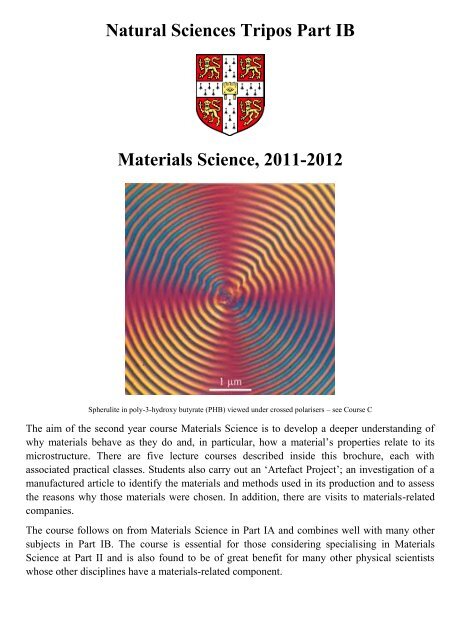Natural Sciences Tripos Part IA - Department of Materials Science ...
Natural Sciences Tripos Part IA - Department of Materials Science ...
Natural Sciences Tripos Part IA - Department of Materials Science ...
Create successful ePaper yourself
Turn your PDF publications into a flip-book with our unique Google optimized e-Paper software.
Course SynopsesCourse A: Phase Transformations (12 lectures): Dr ER WallachImproving metallic materials is a vital activity at theleading edge <strong>of</strong> science and technology. Metals have<strong>of</strong>fered unrivalled combinations <strong>of</strong> properties andreliability over many centuries, generally at affordablecosts. They are versatile because subtle changes in theirmicrostructures can cause significant variations in theirproperties, e.g. the strengths <strong>of</strong> commercial steels rangefrom as low as 50 MPa to up to 5500 MPa. It is possibleto specify and produce metals with very specificproperties and so metals continue to be used in manydifferent applications despite the increased competitionfrom other classes <strong>of</strong> material such as polymers, ceramics and composites. Hence an understanding <strong>of</strong> thedevelopment <strong>of</strong> microstructure in metals is essential for the materials scientist. The course builds on thecoverage <strong>of</strong> metals and alloys in <strong>Part</strong> <strong>IA</strong>. Whereas <strong>Part</strong> <strong>IA</strong> dealt mainly with thermodynamic aspects, kineticsare emphasised when treating phenomena such as diffusion, solidification and solid-state transformations.Course B: Environmental Stability <strong>of</strong> <strong>Materials</strong> (12 lectures): Dr NA RutterAlmost all materials in service are degraded by chemical reactionwith their environment. The phenomenon is called corrosion; it isvery <strong>of</strong>ten corrosion which limits the useful lifetime <strong>of</strong>components. The process is extremely costly - apart fromreplacement costs <strong>of</strong> components, equipment and machinery,corrosion causes failure, sometimes catastrophic, resulting ininjury and loss <strong>of</strong> life. Corrosion or environmental degradationconsumes materials, and the process is thus a drain on the world'smineral resources and energy resources.The phenomenon takes many forms, depending on the material/environment system. This course focuses on thecorrosion and oxidation <strong>of</strong> metals, dealing with how and why metals corrode, how we can predict the processes,and how we can measure them. We will also learn some <strong>of</strong> the principles <strong>of</strong> corrosion protection andprevention.The course will finally also explore how chemical reactions <strong>of</strong> materials can be put to useful technologicaladvantage. We will look at how high-density energy storage in rechargeable, lightweight batteries has been keyto the advancement <strong>of</strong> portable communications devices and we will examine the issues surrounding thedevelopment <strong>of</strong> hydrogen fuel cells for transportation applications.
Course C: Polymers (12 lectures): Pr<strong>of</strong> RE CameronPolymers are very commonly occurring materials, but therelationships between their chemical structure, molecularconformations, and functional properties are far from simple. As“complex fluids”, polymers differ from “simple” molecular liquidsin that they can exhibit a wide range <strong>of</strong> partially ordered phases thatshow behaviour intermediate between a liquid and a solid. Suchsystems are generally described as “self-organising”, and this behaviour can be exploited to fabricate complexstructures from the molecular level upwards. It can also give rise to unusual mechanical behaviour, such as theshear thinning <strong>of</strong> a molten polymer or the entropic modulus <strong>of</strong> a cross-linked rubber. The course aims to give abasic overview <strong>of</strong> the most commonly occurring polymeric materials, and some <strong>of</strong> the techniques forcharacterising their structure and mechanical properties.Course D: Mechanics <strong>of</strong> <strong>Materials</strong> and Structures (12 lectures): Dr PD BristoweAny structure, whatever its function, must be able towithstand the loads imposed upon it during its lifetime. Whilemere survival may sometimes be enough, <strong>of</strong>ten such loadsmust be carried efficiently. Building on ideas introduced in<strong>Part</strong> <strong>IA</strong>, this course aims to understand the approaches thatcan be used to enable materials and structures to withstandstresses efficiently by considering both the nature <strong>of</strong> thestresses and how materials respond to them both elasticallyand irreversibly, illustrating these concepts using bothsynthetic and biological materials and structures.Course E: Electronic <strong>Materials</strong> and Devices (9 lectures): Dr ND MathurThe electronic properties <strong>of</strong> materials constitute afascinating subject <strong>of</strong> great technologicalsignificance. We will see how the most basiccomponents – metals, semiconductors and insulators– may be understood within a single coherentframework. This requires a quantum-mechanicaltreatment <strong>of</strong> the valence electrons, in a crystal devoid<strong>of</strong> microstructure. We will then investigate the keyrole <strong>of</strong> dopant atoms in semiconductors, beforeturning to semiconductor devices, i.e. the buildingblocks <strong>of</strong> the electronics industry.
Relationship to other Courses in <strong>Materials</strong> <strong>Science</strong><strong>Part</strong> <strong>IA</strong> <strong>Part</strong> IB <strong>Part</strong> II <strong>Part</strong> III<strong>Materials</strong> <strong>Science</strong> <strong>Materials</strong> <strong>Science</strong> <strong>Materials</strong> <strong>Science</strong> <strong>Materials</strong> <strong>Science</strong>(BA Hons)(BA Hons MSci)(Earth <strong><strong>Science</strong>s</strong>)(Physics)(Chemistry)(Geological <strong><strong>Science</strong>s</strong>)(Physics)(Chemistry)<strong>Part</strong> <strong>IA</strong> <strong>Materials</strong> <strong>Science</strong> is normally a pre-requisite for students wishing to study for the <strong>Part</strong> IB course in<strong>Materials</strong> <strong>Science</strong>. <strong>Part</strong> IB <strong>Materials</strong> <strong>Science</strong> is commonly combined with Chemistry, Physics, Geological<strong><strong>Science</strong>s</strong> or Mathematics within the <strong>Natural</strong> <strong><strong>Science</strong>s</strong> <strong>Tripos</strong>; however, many other combinations are alsopossible. This course leads on to third (and fourth) year courses in <strong>Materials</strong> <strong>Science</strong>. It is also ideal preparationfor students wishing to specialise in Physics, Chemistry or Geological <strong><strong>Science</strong>s</strong> in later years.Laboratory WorkTimetabled Experiments are run in conjunction with the courses to complement the material taught formally inthe lecture theatre. There is one 2.5 hour afternoon session each week, and you are also expected to carry out afurther 2 hours <strong>of</strong> practical work per week in your own time, which consists <strong>of</strong>:Microscopy An important part <strong>of</strong> the course is to understand the microstructure <strong>of</strong> materials. This is achieved inthe Michaelmas Term through examination <strong>of</strong> materials by optical microscopy and scanning electronmicroscopy. A number <strong>of</strong> prepared specimens are examined and results discussed with your supervisor.Examination <strong>of</strong> a Manufactured Article: the „Artefact Project‟ During the Lent Term you will carry out aninvestigation <strong>of</strong> a manufactured article containing a range <strong>of</strong> different materials. By appropriate sectioning,microscopy and analysis, the materials used are identified and the methods <strong>of</strong> fabrication determined.Industrial VisitsThere will be several visits to companies involved in materials–related industries. Examples <strong>of</strong> recent visitsinclude Hexcel, TWI and Marshall Aerospace.ExaminationsAll students sit two 3-hour theory papers in the Easter Term. The marks from the papers will be added to themarks for the Artefact Project and credit earned for completion <strong>of</strong> the practical course to give a final grade.Contact Details and Further InformationIf you have any queries about the course, please do not hesitate to contact the Head <strong>of</strong> Year, Dr James Elliott(jae1001@cam.ac.uk). The <strong>Department</strong> website hosts information regarding all the undergraduate courses in<strong>Materials</strong> <strong>Science</strong>, please see http://www.msm.cam.ac.uk/Teaching/
















